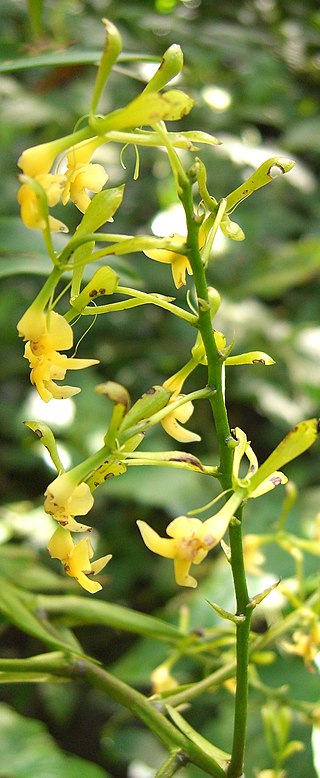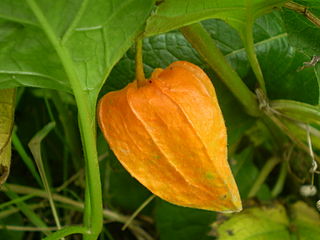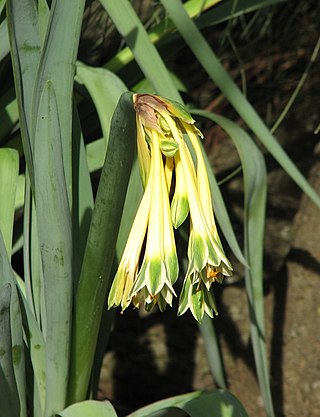
Stipa is a genus of around 300 large perennial hermaphroditic grasses collectively known as feather grass, needle grass, and spear grass. They are placed in the subfamily Pooideae and the tribe Stipeae, which also contains many species formerly assigned to Stipa, which have since been reclassified into new genera.

Iochroma is a genus of about 34 species of shrubs and small trees belonging to the nightshade family Solanaceae. Species are native from Mexico to south Brazil. They are found in the forests of Mexico and South America. Their hummingbird-pollinated flowers are tubular or trumpet-shaped, and may be blue, purple, red, yellow, or white, becoming pulpy berries. The cupular (cup-shaped) calyx is inflated in some species. The leaves are alternate, simple, and entire.
Michel Félix Dunal was a French botanist. He was a professor of botany in Montpellier, France.

Azorella is a genus of flowering plants in the family Apiaceae, native to South America, New Zealand, southeastern Australia, and the islands of the Southern Ocean.

Calceolaria, also called lady's purse, slipper flower and pocketbook flower, or slipperwort, is a genus of plants in the family Calceolariaceae, sometimes classified in Scrophulariaceae by some authors. This genus consists of about 388 species of shrubs, lianas and herbs, and the geographical range extends from Patagonia to central Mexico, with its distribution centre in Andean region. Calceolaria species have usually yellow or orange flowers, which can have red or purple spots. The Calceolaria Herbeohybrida group, also called C. herbeohybrida Voss, is a group of ornamental hybrids known only in cultivation, called florists' slipperwort.

Calandrinia is a genus of flowering plants known as purslanes and redmaids. It includes 37 species of annual and perennial herbs which bear colorful flowers in shades of red to purple and white. Species of this genus are native to the Americas, including western and southern South America, Central America, and western North America. Some species have been introduced to parts of Australia, New Zealand, southern Africa, Asia, and Europe. Over 60 species native to Australia and New Guinea that were formerly included in Calandrinia are now placed in a separate genus, Rumicastrum or Parakeelya. A single eastern Australian species named in 2022, Calandrinia petrophila, is still included in Calandrinia, but will be placed into the Australian genus when the name of the new genus is finally settled.

Baccharis is a genus of perennials and shrubs in the aster family (Asteraceae). They are commonly known as baccharises but sometimes referred to as "brooms", because many members have small thin leaves resembling the true brooms. They are not at all related to these however, but belong to an entirely different lineage of eudicots. B. halimifolia is commonly known as "groundsel bush", however true groundsels are found in the genus Senecio.

Weinmannia is a genus of trees and shrubs in the family Cunoniaceae. It contains 90 species, which range from Mexico through Central and South America including the Caribbean, and to the Mascarene Islands in the western Indian Ocean. It is absent from mainland Africa and Australia, but some fossils have been attributed to Weinmannia in Australia.

Geonoma is a genus of small to medium-sized palms native to the forest understorey of tropical Central and South America.

Tournefortia, often called soldierbushes, is a genus of flowering plants in the borage family, Boraginaceae.

José Antonio Pavón Jiménez or José Antonio Pavón was a Spanish botanist known for researching the flora of Peru and Chile.

Iochroma arborescens is a species of flowering plant in the genus Iochroma, belonging to the nightshade family Solanaceae. Formerly it was considered the single species in the monotypic genus Acnistus. Common names include gallinero, mata-gallina, fruta-de-sabiá, hollowheart, wild tobacco, siyou, bastard sirio, galán arbóreo, tabaco de monte, nigüito, marieneira, güitite, and tabak djab.

Epidendrum paniculatum is a species of orchid in the genus Epidendrum.

Physaleae is a tribe of flowering plants in the subfamily Solanoideae of the family Solanaceae.

Clinanthus is a genus of bulbous plants in the family Amaryllidaceae. It is found in western South America, including Ecuador, Peru, Bolivia, north Chile and north west Argentina.

Jaltomata is a genus of plants in the family Solanaceae. According to molecular phylogenies, Jaltomata is the sister genus to Solanum, which includes tomato, potato, and eggplant. Jaltomata has a neotropical distribution, in that species occur from the United States southwest through Latin America, and into the Andean region of South America. Species encompass a wide range of vegetative and reproductive trait variation, including growth habit, floral size, shape and color, as well as fruit size and color. The fruits of some of the species are eaten by humans in Latin and South America. Depending on the species, fruits may be red, green, orange, or dark purple.

Mesechites is a genus of plants in the family Apocynaceae first described as a genus in 1860. It is native to Mexico, Central America, South America, and the West Indies.
- Mesechites acuminatus Müll.Arg. - Peru
- Mesechites angustifolius(Poir.) Miers - Hispaniola
- Mesechites citrifolius(Kunth) Woodson - Colombia
- Mesechites mansoanus(A.DC.) Woodson - Paraguay, Brazil
- Mesechites minimus(Britton & P.Wilson) Woodson - Cuba
- Mesechites repens(Jacq.) Miers - Hispaniola, Navassa Island, Jamaica
- Mesechites roseus(A.DC.) Miers - Cuba
- Mesechites trifidus(Jacq.) Müll.Arg. - widespread from Tamaulipas in NE Mexico south to Paraguay + N Argentina
- Mesechites andrieuxii(Müll.Arg.) Miers = Mandevilla convolvulacea(A.DC.) Hemsl.
- Mesechites angustatusMiers = Mandevilla benthamii(A.DC.) K.Schum.
- Mesechites brownei(A.DC.) Miers = Mandevilla torosa(Jacq.) Woodson
- Mesechites dichotomus(Kunth) Miers = Laubertia boissieriA.DC.
- Mesechites guayaquilensisMiers = Mandevilla subsagittata(Ruiz & Pav.) Woodson
- Mesechites guianensis(A.DC.) Miers = Mandevilla rugellosa(Rich.) L.Allorge
- Mesechites hastatusMiers = Mandevilla subsagittata(Ruiz & Pav.) Woodson
- Mesechites hirtellulusMiers = Mandevilla oaxacana(A.DC.) Hemsl.
- Mesechites hirtellus(Kunth) Miers = Mandevilla subsagittata(Ruiz & Pav.) Woodson
- Mesechites jasminiflorus(M.Martens & Galeotti) Miers = Mandevilla subsagittata(Ruiz & Pav.) Woodson
- Mesechites lanceolatus(R.Br.) Miers = Parsonsia lanceolataR.Br.
- Mesechites oaxacanus(A.DC.) Miers = Mandevilla oaxacana(A.DC.) Hemsl.
- Mesechites ovalis(Ruiz & Pav. ex Markgr.) Pichon = Allomarkgrafia ovalis(Ruiz & Pav. ex Markgr.) Woodson
- Mesechites plumeriiflorus(Woodson) Pichon = Allomarkgrafia plumeriifloraWoodson
- Mesechites siphiliticus(L.f.) Lemée = Tabernaemontana siphilitica(L.f.) Leeuwenb.
- Mesechites subcarnosus(Benth.) Miers = Mandevilla subcarnosa(Benth.) Woodson
- Mesechites sulphureus(Vell.) Müll.Arg. = Prestonia coalita(Vell.) Woodson
- Mesechites torulosus(L.) Miers =Mandevilla torosa(Jacq.) Woodson
Morisonia is a genus of flowering plants in the family Capparaceae, found across the Americas from the United States to Argentina. They are typically shrubs or small trees. The genus was recently enlarged with New World Capparis species due to existing taxonomic instability.
















